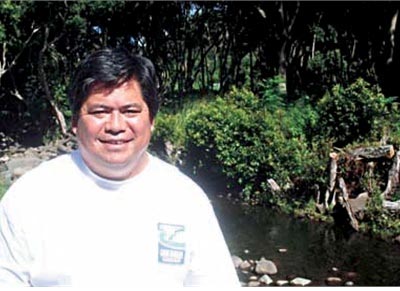Kahu David Kapaku: A Hawaiian speaks out
BEYOND THE BEACH By Norm Bezane
“If you love Maui, you have a responsibility to learn as much as you can,” declared Kahu David Kapaku.
Sitting in beautiful Honokohau Valley, where his direct relatives settled 900 years ago, Kapaku, a minister of the Ka’ahumanu Church and holder of bachelor’s, master’s and doctorate degrees in Religious Studies, has powerful stories to tell.

What this smart, perceptive son of the north shore has to say about change sweeping the island, development, Hawaiian traditions, Christianity and mythical gods offers anyone curious about this place much food for thought.
Hawaii has long been a magnet for newcomers, setting up a clash between new and old. When Tahitians migrated to the Big Island ten centuries ago and changed the religion, they enlisted thousands of Hawaiians to carry two million pounds of rocks 20 miles to build more elaborate heiaus (places of worship) for human sacrifice. The Makihous, the family name on his mother’s side, wanted none of this and fled to Hana.
They traveled around the coast to the most beautiful spot they could find: Honokohau Valley. Kapaku’s great, great, great grandfather fought with King Kamehameha I’s warriors in the bloody battle of Iao Valley. Chiefs, priests and taro farmers, all ancestors of Kapaku, thrived. Much later, Chinese immigrants came to their valley to help with pineapple. And then came resorts and people arriving on jet planes. Some of the newcomers assimilated, some didn’t.
“There are people who have been here 40 years who still do not understand Hawaiians or our traditions,” Kapaku observed. “Thirty years ago, when people came to live here, they adapted. People wanted to surf, just hang out. Now it is all business. ’How can I make money off this condo and sell it for twice as much.’ Today they have to have a big house and want Maui to be like California.”
“Yet there is still a Hawaii where you can hear the wind, you can hear the flowing water. This is what people imagine Hawaii to be. But some say, ’I need more money. I will put a house here. I will build another house there. I will lace this whole area all the way to Olowalu. It’s insanity,” he said.
“People who first come here have a dream of what it would be like,” he said. Visitors the minister meets are disappointed. “They say, ’I think Maui is beautiful,’ but they have old pictures in their minds that Maui is a balmy place. They come and see a Costco, they see a Wal-Mart, and say they were not expecting that.
“This change is very disturbing. It’s disappointing to see very expensive homes that no one is living in – $10 million, $15 million, and no one is there. The greatest disappointment is to see the Hawaiian people having to leave because they can’t afford to live here. I tell people, ’If you went to China, would you expect to see Chinese? If you come to Hawaii, would you expect to see Hawaiians?’ Visitors are surprised to learn the percentage of Hawaiians on Maui is not there. The typical reaction is, ’Are you kidding me?’ ”
For Hawaiians, love of the land is paramount (more about this in a subsequent column). This love is shared by many newcomers.
“The first thing people see when they come here is the beauty; the unfortunate thing is, that is not all there is to see. When you fall in love, you want to know everything. And you begin to learn about (Hawaiians). You see a tree and it is beautiful. But there is more beauty under the surface if you could see the whole thing,” he explained.
Kapaku noted that Hawaiians themselves are like the part of the tree that is invisible.
Kapaku, it appears, harbors no ill feelings for people who have come. But he has important advice: “Leave your agendas back home and get to know who we are; get to know us as Hawaiians.”
This is no easy journey. Kapaku admits that while some Hawaiians are willing to share knowledge of their unique culture and traditions, some are not. But those who love this place, who now make it their home, have a responsibility to try. Read. Talk story. Take courses in Hawaiian culture at Maui Community College’s new Lahaina Education Center. Learn the language – no small feat from personal experience, but whether you become fluent or not, learning Hawaiian words and sentence structure opens windows to the culture.
One good place to bond with Hawaiians is a meeting of the Save Honolua Coalition (see page 7), where newcomers and Kanaka Maoli gather for frank exchanges of views. Watch Lahaina News for times and places. You can even meet Kapaku, who was just named its president. |